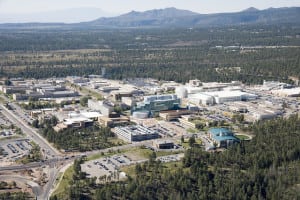The Democrat-led House Armed Services Committee has proposed authorizing a little more funding than requested for the National Nuclear Security Administration’s (NNSA) portfolio of nuclear weapons programs in fiscal year 2022, according to a copy of the chairman’s mark.
Under the draft National Defense Authorization Act (NDAA), the Department of Energy’s NNSA would be authorized to spend more than $19.8 billion in the fiscal year that begins Oct. 1. The White House had requested a little more than $19.7 billion.

The bill has a little extra money to accelerate studies about how plutonium pits — fissile warhead cores — age, plus a larger-than-asked for appropriation for the National Ignition Facility at the Lawrence Livermore National Laboratory, which just reported a record energy output at the decades-old, laser-powered nuclear-fusion experimental facility. NNSA’s international nuclear nonproliferation programs also get a boost.
The House Armed Services Committee was not scheduled to debate its version of the annual must-pass bill until Sept. 1, but Defense Daily obtained a copy of the chairman’s mark.
The committee’s NDAA includes all $2.9 billion requested for construction of plutonium pit factories at the Los Alamos National Laboratory in New Mexico and the Savannah River Site in Aiken, S.C. The two are supposed to produce around a combined 80 pits annually by 2035 or so, initially for the cores of W87-1 warheads to be used on the Air Force’s planned Ground Based Strategic Deterrent intercontinental ballistic missiles starting around 2030.
Unlike the House’s proposed NNSA appropriations bill, the Armed Services Committee’s draft NDAA would provide full funding for the W93 submarine-launched ballistic missile warhead, which is still in the early conceptual phases of design, and a sea-launched variant of the W80-4 air-launched cruise missile warhead.
Like the House’s appropriations bill, the NDAA proposes no funding to extend the life of the megaton-class B83 gravity bomb, which the Trump administration decided to keep in warm storage, reversing the Obama administration’s decision to retire the weapon.
The chairman’s mark is the jumping-off point for debate in the full committee — debate which now will begin without any need for proponents of the current nuclear-weapons modernization program to dig out of a hole just to get the White House’s request for the NNSA authorized.
Authorization bills such as the NDAA set policies and spending limits for the annual appropriations bills that actually determine how much money federal agencies will get from the treasury each year. For 2022, House and Senate appropriators have already approved the requested funding for the NNSA.
At deadline, the two chambers had not produced compromise spending bills for President Biden to sign. The Senate was on its August recess and the House was busy with votes on a bipartisan infrastructure bill and an expansion of social programs though a budget reconciliation process that so far has been a partisan Democrat plan. Without a spending bill by Oct. 1, Congress will have to extend fiscal year 2021 budget with a continuing resolution.
Meanwhile, the draft House NDAA would also require the NNSA and DoE’s Office of Environmental Management to jointly certify the NNSA’s plans to handle radioactive waste created by future pit production. The transuranic waste resulting from the process would have to be buried deep underground at DoE’s Waste Isolation Pilot Plant in Carlsbad, N.M.
The two DoE branches — specifically, the assistant secretary for environmental management and the deputy administrator for defense programs — would have to make the certification whenever one of the NNSA’s two planned plutonium pit production plants hits a critical decision milestone. The next such milestones for the planned factories at the Los Alamos National Laboratory and the Savannah River Site are scheduled for 2023 and early 2024, respectively, NNSA officials have said.
The NNSA has a legal requirement to start casting multiple war-usable pits in 2024, though officials differ on whether the agency will hit that goal in time. Charles Verdon, the current deputy administrator for defense programs, has said NNSA likely will make 30 usable pits in 2026 at the Los Alamos National Laboratory. The military needs at least 80 pits a year by 2030, but NNSA has said it probably cannot hit that throughput until 2032 or 2035.
“We could have the best pit production equipment and the best human beings inside a plutonium facility at Los Alamos, but if we can’t process it and the waste down to [the Waste Isolation Pilot Plant], we’re probably not going to meet our production goals,” Michael Thompson, NNSA’s principal assistant administrator for enterprise capabilities, said Aug. 3 during the annual Nuclear Deterrence Summit, hosted by Defense Daily affiliate publication the Exchange Monitor.